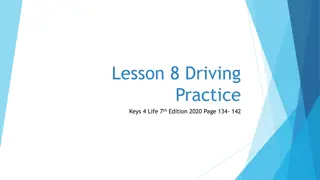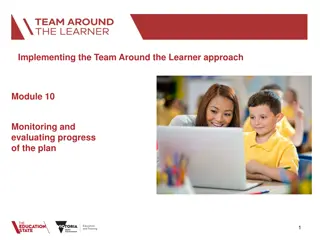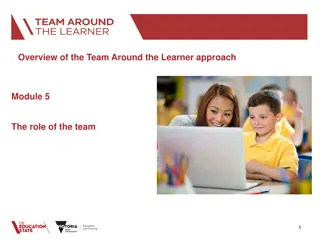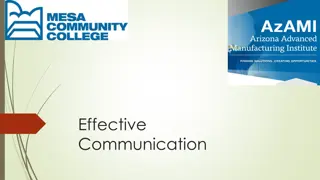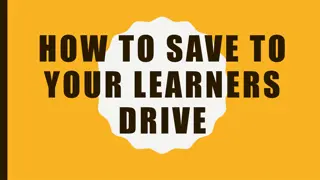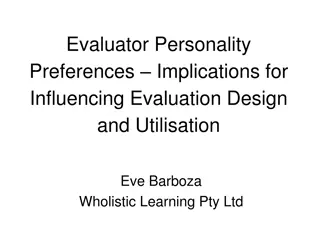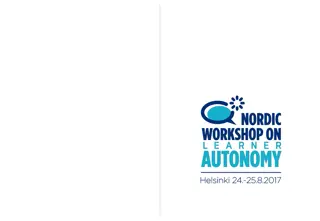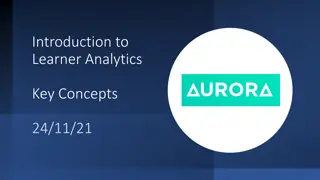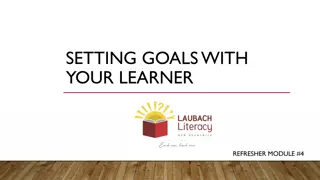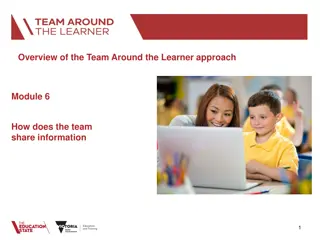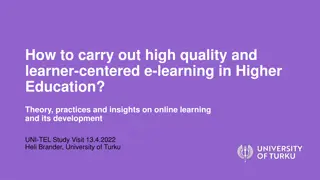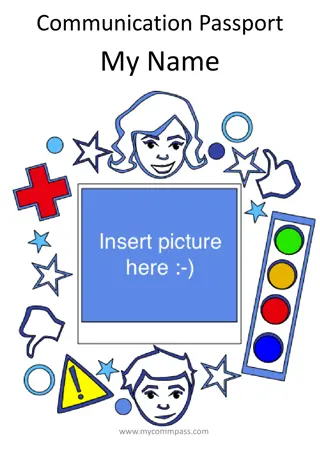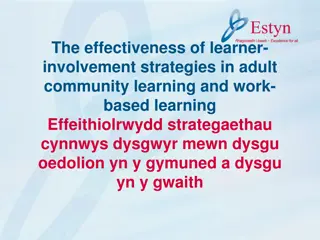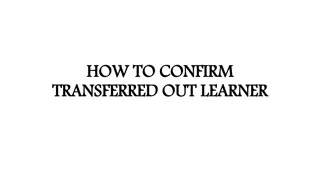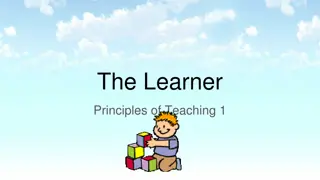Understanding Learner Preferences for Effective Communication Programs
Explore learner preferences and their role in designing instructional communication programs. Learn how to assess preferences, promote communication development, and build a strong foundation for effective programs. Discover key concepts such as behavior as communication and the importance of intentional development in learners with deafblindness.
- Learner Preferences
- Communication Programs
- Instructional Design
- Communication Development
- Deafblindness
Download Presentation

Please find below an Image/Link to download the presentation.
The content on the website is provided AS IS for your information and personal use only. It may not be sold, licensed, or shared on other websites without obtaining consent from the author. Download presentation by click this link. If you encounter any issues during the download, it is possible that the publisher has removed the file from their server.
E N D
Presentation Transcript
Identifying Learner Preferences and Utilizing Results in Designing Instructional Communication Programs Dr. Sarah Ivy sivy@fsu.edu Dr. Susan M. Bashinski sbashinski@missouriwest ern.edu
Overview Purpose and focus of today s webinar Research on preference assessment Case Study: Conducting a variety of preference assessments for a learner with deafblindness Using preferences to promote communication development
Purpose and Focus Over-arching goal: To demonstrate how the use of data from a learner s preference assessment can be effectively combined with the results from a learner s communication skills assessment to build the foundation for an appropriate, powerful communication program
Purpose and Focus (cont.) Many learners with deafblindness move more slowly through the developmental phase of using a variety of behaviors intentionally but NOT in an intentionally communicative way Young children who are neurotypical generally move through this phase relatively quickly and without direct instruction! Development of intentional communication is a critically important, but very challenging task
Two Key Concepts - #1 Behavior IS communication!
Key Concept #1 Two primary ways to view the overt behaviors learners demonstrate . through a BEHAVIORAL filter or through a COMMUNICATION filter. Which filter do YOU use?
Two Key Concepts - #2 Intentionality Development Defined as: Deliberate pursuit of a goal, as well as the means to obtain the goal
Key Concept #2 Two primary elements for characterizing a learner s overt behaviors, in terms of INTENTIONALITY.... 1. 2. Intentional behavior Intentional communication (means to have impact on another person, not just objects)
Sequence of Intentionality Development For the purposes of today s webinar, we shall identify and focus on these primary stages: (Nonintentional [or preintentional]) Intentional behavior Intentional unconventional communication Transition to conventionality Transition to intentional conventionality
Nonintentional / Preintentional In this stage, a learner is neither deliberately pursuing a goal nor aware of a means to obtain the goal Behaviors are idiosyncratic A communication partner must interpret the learner s behaviors as if they were intentional (Consistent, repeated interpretations by partners, over time, will shape intentionality.)
Intentional Behavior Behavior IS under the learner s control (i.e., intentional) Behavior is NOT used to communicate intentionally Behavior IS meaningful in context The learner does not realize she can use these behaviors to control another person s behavior.
Intentional Unconventional Communication Behavior IS intentionally communicative Intentional communication means to have an impact on another person, not just on objects NOT symbolic Unconventional because these forms are not acceptable to use as grow older
Transition to Conventionality Behavior IS used to intentionally communicate Conventional gestures / vocalizations Communicative messages are understood by members of the same culture Communicative forms are socially acceptable to use as grow older
Transition to Intentionality Conventionality Partner s responsibility for success of a communication interaction is diminished Communicative context is important, but less so than in the nonsymbolic stage Learner is likely to demonstrate concrete symbolic expressions (i.e., with 3-D objects)
As we move now to a critical examination of PREFERENCE ASSESSMENT, it is critical to remember that . Communication is both a skill and a sensorimotor experience And how very important it is to . Maximize the learner s sensory access.
Before we continue. QUESTIONS?
Importance of Preferences Incorporating preferences in instruction can be both motivating and reinforcing Increase engagement and interest Use reinforcers to increase skill level Decrease problem behaviors *Students with deafblindness often have a limited repertoire of preferences
Preference Assessment Methods Indirect Assessments Interviews Observations Research shows direct assessments are more accurate than indirect assessments Parents tend to inaccurately predict preference for unfamiliar items (Kenzer & Bishop, 2011) Direct Assessment Single Stimulus Multiple Stimulus with and without Replacement Pairwise or forced choice Free Operant Reinforcer Assessment
Findings from Virues-Ortega et al. (2014) Related to Sensory and Motor Disability Teacher concern about adapting PA methods for learners with profound disabilities, particularly with VI, motor disability (MD), and difficult behaviors Participants included learners with VI (7 studies) or deafness (1 study), but not deafblindness Eye gaze and emotional behaviors (indirect responses) used more frequently for learners with VI and/or MD Pairwise assessments most often used for VI/MD
Decision Making: Type of results needed (e.g., tangible, hierarchy), student characteristics (purely behavioral), time constraints Virues-Ortega et al., 2014
Case Study: John 7 Years old Chromosomal anomalies 20/200 or worse with correction Binaural hearing loss (at least 70dB) Able to actively reach, grasp, manipulate SIB-R showed age equivalence of 5-7 months Majority of John s behaviors seem to be intentional, though only a small percentage to be intentional unconventional communication Music, lights, scratching, rolling, kicking
Scenario 1: engagement or selection response requires intentionality, which student does not have
IRPA: Indirect/idiosyncratic response PA Scenario 2: engagement or selection does not require intentionality, and student can select with reach and grasp
IRPA: Indirect/idiosyncratic response PA Scenario 3: DB precludes student s ability to select without exploration, therefore we rely on engagement measured by emotional response
Preference Assessment Procedures (adapted from Picture Exchange Communication System) 1. Interviews with parents and teacher 2. Free play observations at home and school 3. Single stimulus preference assessments Selection responses Indices of happiness, protest, and rejection *Parents also predicted preferences from direct assessment
Research Questions Can the manualized Picture Exchange Communication System (PECS) preference assessment procedures be used to identify tangible preferences for a unique learner with deafblindness? Can the preference assessment procedures be adapted to obtain useful information regarding learner preferences?
? Interviews 1. List up to 10 items for each category. Include only those items that your student or child currently enjoys (or dislikes for the final category). Then number each item from most to least preferred (with most preferred being 1) within each category. Category Things your student/child likes to eat Things your student/child likes to drink Social games your student/child likes (Peek-a- boo, chase, tickles, etc.) Places your student/child likes to visit What your student/child chooses to do during free time Activities your student/child likes (watching television, spinning, sitting in a special chair, squeezese, etc.) People your student/child recognizes and enjoys being with Items, activities your student/child DOES NOT like Items/Activities 2. Then rank order items/activities across categories.
Interview Results Rank Parents Teacher Summary 1 Grandpa (tickles, snuggles, bounces) Tickles Proprioceptive: tickles, snuggles, bounces, deep pressure, drums 2 Music (gospel, deep voice, country) Floor time (mat) Proprioceptive: tickles, snuggles, bounces, deep pressure, drums 3 Floor time (carpet, tile) Floor time (tile) Proprioceptive: tickles, snuggles, bounces, deep pressure, drums 4 Tickles Scratching textures Tactual: breeze, water stuff, scratching textures, floor time 5 Peek-a-boo Repetitive movement Tactual: breeze, water stuff, scratching textures, floor time 6 Sweet potatoes Swinging Tactual: breeze, water stuff, scratching textures, floor time 7 Snickerdoodle cookies Close contact, deep pressure Vestibular: repetitive movement, swing 8 Grapes Drums Vestibular: repetitive movement, swing 9 Grandma s potato salad Water stuff Auditory: music, drums 10 Meatloaf Parachute (breeze) Food
Activities in Free Play Colorful, easy to grasp, O-ball Shiny mylar pom pom Rattle Lever toy I want to observe your child/student in a free play situation to see how she/he might choose to spend his/her time. Your child/student does not have to play with these items. This is free play. He can spend his time playing anything he wants. Please help your child/student only if he needs help. If your child/student requests to play with you, you can play with him as you typically would. We want this to be as natural as possible. Are you ready?
Single Stimulus Assessments (1st) Allow student to experience item for 15-30 seconds This will depend on the access abilities of the student and the qualities of the item. Allow student to experience all qualities of the item (see item descriptions) allowed by the student s abilities. Show student how to operate item if appropriate. Keep focus on item, not social interaction. The intent is to get the student to understand the properties of the item. If student uses item in an inappropriate manner, block and/or redirect after 2s. Record if student: Rejected (If reject, go to next trial) Had no reaction Showed signs of pleasure Reaches for within arm distance
Single Stimulus Assessments (2nd) Stop operation of item and pull item away from student out of arms reach (do not grab item), still within line of vision, for 5 seconds Record if student: Tried to obtain when out of reach Protested when you stopped the experience
Single Stimulus Assessments (3rd) Present item in accessible manner for up to 20 seconds, but do not force or prompt student to take the item Alert student to the presence of the item, either visually, auditorily (e.g., turn on/off quickly, crinkle wrapper), or tactually (e.g., quickly touch to students hand and pull away). Be thorough in your attempt. The intent is to let student know item is available, but that he/she has to indicate desire for item. Record if student: Reaches for within arm distance Take item again
Single Stimulus Assessments (4th) Release item if apprehended, but do not praise student for accepting. If taken, shape student behavior as needed to interact with the item in an appropriate manner. If student uses item in an inappropriate manner, block and/or redirect after 2s. Retrieve item within 20 seconds (again, do not grab item you may prompt student that you are going to take item). Record if student: Shows signs of pleasure Protests when taken away Overcomes minor obstacles
Agreement Among Assessments for Highly Preferred and Non-Preferred Direct PA T2 Preferred: Sound machine Tiger Tambourine Minion toy Non Preferred: Nothing Teacher Clapper toy Pom Pom Lotion Fan Tambourine Sound machine Parents Bubble toy Massager Tambourine Sound machine Fan Cymbals Direct PA T1 Preferred: Clapper toy Kazoo Fan Bubble toy Button book app Light up ball Non Preferred: Tambourine Slinky Pom Pom
Agreement Among Assessments for Highly Preferred Teacher Clapper toy Pom Pom Lotion Fan Tambourine Parents Bubble toy Massager Tambourine Sound machine Fan Direct PA Total Score Sound machine Tiger Fan Light up ball Kazoo 1. Single stimulus assessment did not differentiate relative preference Assessments appear to be highly dependent on time or partner Did parents inaccurately predict preferences? 2. 3.
SoLets Begin to Connect this Preference Work to Communication Children and young adults who experience deafblindness, particularly young children, typically initiate little exploration In fact, many children need to be invited out of their own bodies,to join us in the world In the case of a learner who also experiences significant motor challenges, the lack of exploration is further exacerbated
SoLets Begin to Connect this Preference Work to Communication (cont.) In these instances, direct assessments (as recommended by Virues-Ortega et al., 2014) need to be supplemented with unstructured observation Potential communication partners need to observe, and record, any intentional overt behavior in which a child routinely engages
Before we continue. QUESTIONS?
School Observation Observer 1 1. Holding glasses 2. Scratching mat surface 3. Putting object or thumb in mouth 4. Moving/kicking holding up legs 5. Holding a mylar toy Observer 2 1. Scratching mat surface 2. Holding glasses 3. Putting object or thumb in mouth 4. Smacking face 5. Holding a mylar toy Inter-observer Agreement: 95.3% 1. Tactile 2. Auditory 3. Visual
Home Observation Observer 1 1. Sucking thumb 2. Playing with hands 3. Moving/kicking/holding up legs 4. Holding head up 5. Looking at hands Inter-observer Agreement: 93.0% 1. Tactile 2. Proprioceptive 1. Tactile 2. Proprioceptive Observer 2 1. Sucking thumb 2. Moving/kicking/holding up legs 3. Playing with hands 4. Looking at hands 5. Making noises 3. Vestibular 3. Visual 4. Visual 4. Vestibular
Before we continue. QUESTIONS?
Communication Assessment For the purposes of illustration in this webinar, we ll use the Communication Matrix for Parents and Professionals (Rowland, 2013) to illustrate how sensory and communication assessment can and SHOULD: 1. Inform one another (e.g., incorporate learner preferences within env. context, choices, etc.) 2. Be utilized for programmatic decision-making
Communication Assessment Methods: Function Categories Over-arching function categories: Refuse Obtain Social Information
Communication Assessment Methods: Levels of Communication Development Levels of Communication Development 1. Nonsymbolic, pre-intentional 2. Intentional behavior 3. Intentional, unconventional communication 4. Transition to intentional conventionality (plus 5, 6, and 7 )
Communication Assessment Methods Results Profile
Using Preferences to Promote Communication Development Listen with your eyes, and hands, and heart . Talk with more than your mouth . & Keep the learner s preferences in mind!





